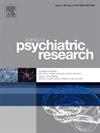加强对青少年抑郁症发病的预测:一种机器学习方法。
IF 3.7
2区 医学
Q1 PSYCHIATRY
引用次数: 0
摘要
重度抑郁症(MDD)是一种普遍的心理健康状况,通常始于青春期,具有重要的长期影响。针对症状轻微的青少年的指示性预防方案已经显示出效果,但是识别高危个体的方法需要改进。本研究旨在评估偏最小二乘回归(PLSR)在预测非抑郁青少年MDD发病方面的效用,并与传统筛查方法进行比较。该研究招募了1462名13-16岁的葡萄牙青少年,使用各种自我报告方法对他们进行评估,并随访了两年。参与者随机分为训练样本(70%,N = 1023)和测试样本(30%,N = 439)。PLSR模型用于预测两年内重度抑郁发作(MDE)的发生,使用331个变量。将该模型与儿童抑郁量表(CDI)在预测MDE发作方面的表现进行比较。具有两个分量的最佳拟合PLSR模型分别解释了训练样本和测试样本中19.1%和16.9%的方差,显著优于CDI模型,CDI模型解释了7.7%的方差。PLSR的ROC曲线下面积为0.78,而CDI为0.71。使用经验推导的截止点来创建二分类风险类别,并显示预测高风险组和低风险组之间MDE率的显着差异。PLSR模型的平衡精度为0.77,而CDI方法为0.65。PLSR模型有效地识别出有发展重度抑郁症风险的青少年,显示出比CDI更强的预测能力。本研究支持ML技术(如PLSR)在加强青少年抑郁症的早期识别和预防方面的潜在效用。本文章由计算机程序翻译,如有差异,请以英文原文为准。
Enhancing prediction of major depressive disorder onset in adolescents: A machine learning approach
Major Depressive Disorder (MDD) is a prevalent mental health condition that often begins in adolescence, with significant long-term implications. Indicated prevention programs targeting adolescents with mild symptoms have shown efficacy, yet the methods for identifying at-risk individuals need improvement. This study aims to evaluate the utility of Partial Least Squares Regression (PLSR) in predicting the onset of MDD among non-depressed adolescents, compared to traditional screening methods. The study recruited 1462 Portuguese adolescents aged 13–16, who were assessed using various self-report measures and followed for two years. Participants were randomly divided into training (70%, N = 1023) and testing (30%, N = 439) samples. PLSR models were developed to predict the occurrence of a major depressive episode (MDE) within two years, using 331 variables. The model's performance was compared to the Children's Depression Inventory (CDI) in predicting MDE onset. The best-fitting PLSR model with two components explained 19.1% and 16.9% of the variance in the training and testing samples, respectively, significantly outperforming the CDI, which explained 7.7% of the variance. The area under the ROC curve was 0.78 for PLSR, compared to 0.71 for CDI. An empirically derived cut-off point was used to create dichotomous risk categories, and it showed a significant difference in MDE rates between predicted high-risk and low-risk groups. The balanced accuracy of the PLSR model was 0.77, compared to 0.65 for the CDI method. The PLSR model effectively identified adolescents at risk for developing MDD, demonstrating superior predictive power over the CDI. This study supports the potential utility of ML techniques (e.g., PLSR) in enhancing early identification and prevention efforts for adolescent depression.
求助全文
通过发布文献求助,成功后即可免费获取论文全文。
去求助
来源期刊

Journal of psychiatric research
医学-精神病学
CiteScore
7.30
自引率
2.10%
发文量
622
审稿时长
130 days
期刊介绍:
Founded in 1961 to report on the latest work in psychiatry and cognate disciplines, the Journal of Psychiatric Research is dedicated to innovative and timely studies of four important areas of research:
(1) clinical studies of all disciplines relating to psychiatric illness, as well as normal human behaviour, including biochemical, physiological, genetic, environmental, social, psychological and epidemiological factors;
(2) basic studies pertaining to psychiatry in such fields as neuropsychopharmacology, neuroendocrinology, electrophysiology, genetics, experimental psychology and epidemiology;
(3) the growing application of clinical laboratory techniques in psychiatry, including imagery and spectroscopy of the brain, molecular biology and computer sciences;
 求助内容:
求助内容: 应助结果提醒方式:
应助结果提醒方式:


